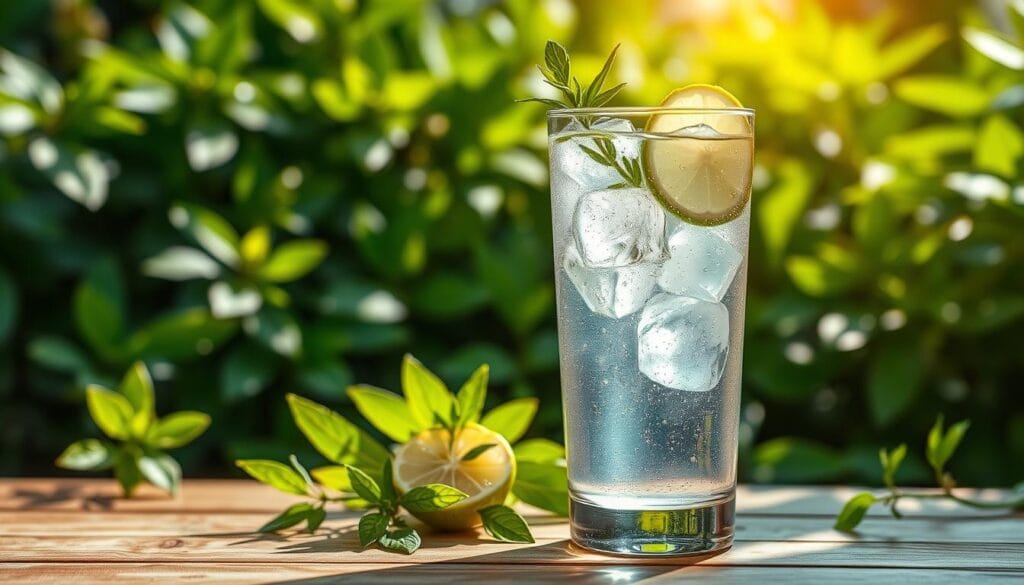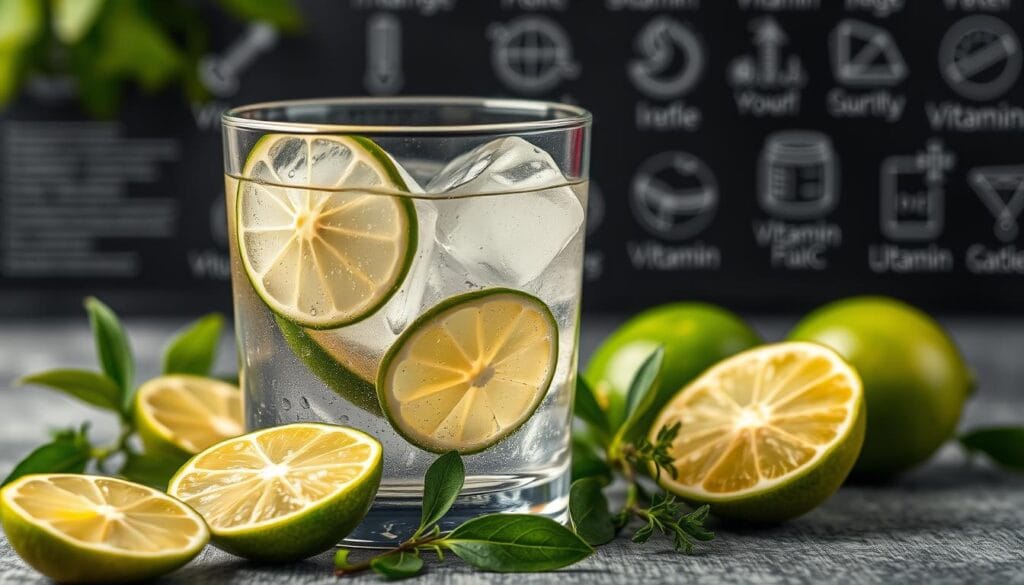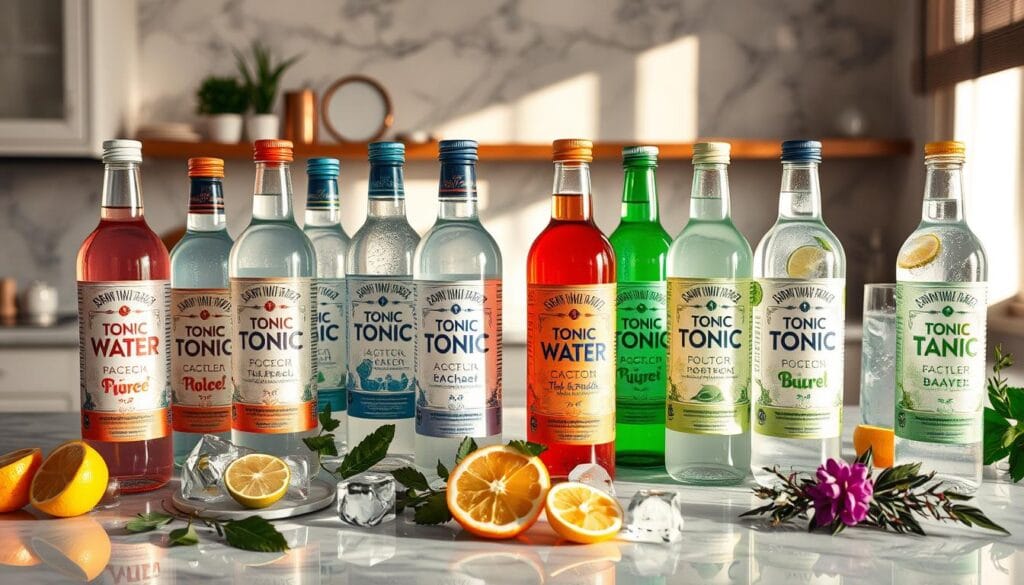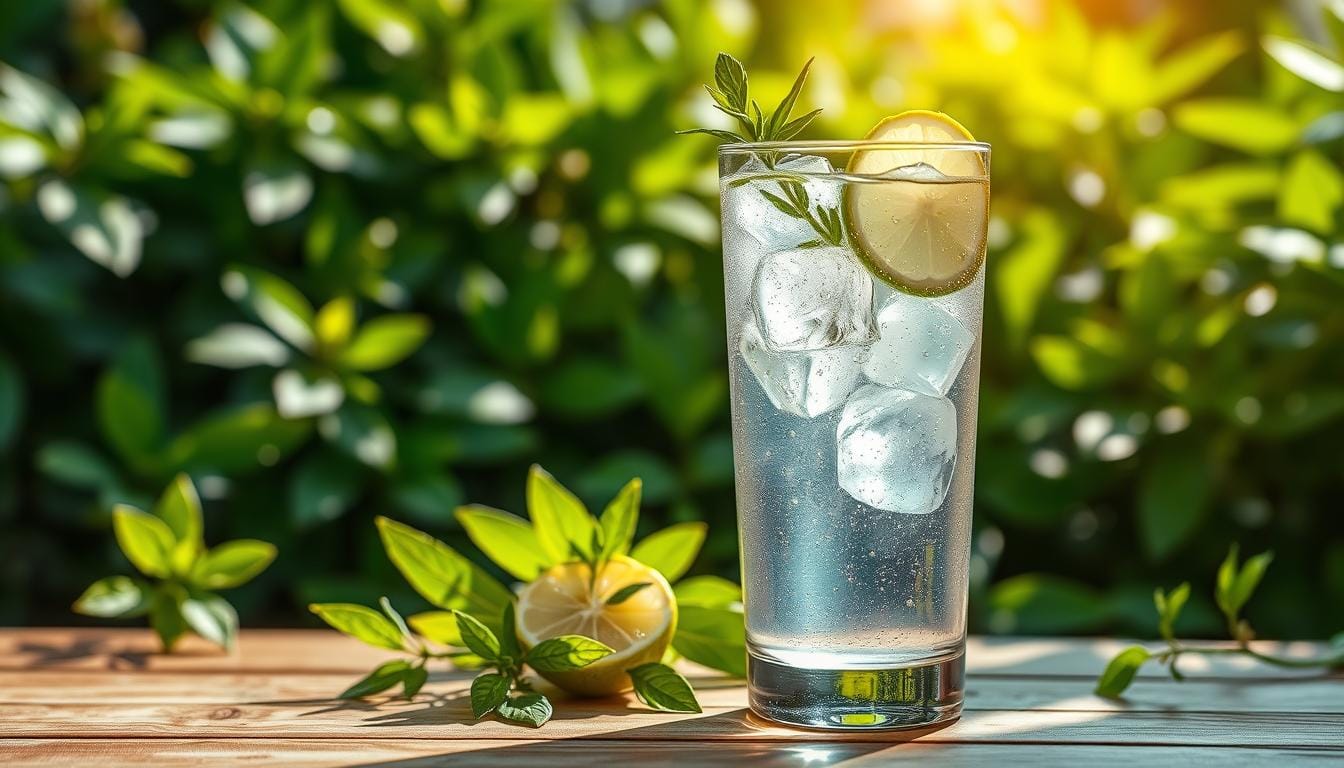Tonic Water Nutrition Info: What You Should Know Before Drinking
Tonic water is a carbonated soft drink that’s been a favorite for mixing drinks for years. It might seem like a cool and safe choice for your cocktail. But, it’s key to know what’s in tonic water before you drink it. This includes calories, sugar, and the role of quinine.
This guide will help you understand tonic water better. It will give you the info you need to choose your drinks wisely.

Table of Contents
Understanding Tonic Water Nutrition Basics
Tonic water is a fizzy drink with a unique bitter taste. This comes from quinine, a compound from the cinchona tree bark. Quinine has been used for centuries to fight malaria. It makes tonic water different from other fizzy drinks like club soda or seltzer water.
What Makes Tonic Water Different
What sets tonic water apart is the quinine. Unlike club soda and seltzer water, tonic water has quinine for a more complex taste. It also has sweeteners like sugar or high-fructose corn syrup to balance the bitterness.
History and Evolution of Tonic Water
Tonic water’s history goes back to the 17th century as a malaria treatment. British colonial officers in India mixed it with gin to make it taste better. This created the famous gin and tonic cocktail. Over time, it evolved from a medicinal drink to a popular mixer in many cocktails and drinks.
Common Uses and Applications
- Mixing with gin to create the classic gin and tonic cocktail
- Combining with vodka, white rum, or other spirits to make a variety of mixed drinks
- Serving as a non-alcoholic, carbonated mixer for fruit juices or other flavors
- Enjoying as a refreshing, standalone beverage on its own
Today, tonic water is a versatile and popular choice in mixology and beyond. Its unique flavor continues to delight people around the world.
The usual tonic water is a fizzy soft drink with quinine. High doses of quinine can be toxic. The FDA sets limits on quinine in tonic water for safety. Bartenders suggest a 2-ounce gin to 4-6 ounces tonic water mix for a Gin and Tonic. This mix is about 10% alcohol by volume.
Tonic Water Nutrition Info
Many think tonic water is a better choice than sugary sodas. But, the facts might shock you. A 12-ounce tonic water has 124 calories, 32.2 grams of carbs, and 32.2 grams of sugar. This is similar to regular soda, making tonic water not as healthy as you might believe.
The main ingredient in tonic water is quinine. The FDA allows up to 83 parts per million in soft drinks. Quinine was once used for health, but now it’s mainly for flavor.
| Nutritional Information (per 12-oz serving) | Tonic Water |
|---|---|
| Calories | 124 |
| Carbohydrates | 32.2g |
| Sugars | 32.2g |
| Sodium | 43.9mg |
| Quinine | 20-30mg |
If you want to cut down on carbs in tonic water and tonic water calories, try diet tonic water. It uses artificial sweeteners to reduce calories. But, it might have health risks from artificial ingredients.
Even though tonic water tastes good and refreshing, knowing its nutritional profile and health impact is key. Making smart choices means reading labels and understanding what’s in is tonic water healthy?
The Role of Quinine in Tonic Water
Quinine is a key ingredient in tonic water. It has a long history as a malaria treatment. Today, the FDA ensures it’s safe in carbonated drinks like tonic water.
Historical Medical Uses
Quinine comes from the cinchona tree bark, found in Central and South America. For ages, it helped treat malaria, a deadly disease. It lowered fever and eased malaria symptoms, making it very valuable.
Modern Applications
Though better treatments exist, quinine is still in tonic water. Its unique taste makes it great for mixing with gin and vodka. This makes tonic water a favorite in cocktails.
Safety and Regulation
The FDA says it’s safe to have up to 83 parts per million of quinine in drinks. But too much can cause nausea, headaches, and vision problems. People with heart or kidney issues should be careful. Always talk to a doctor before drinking tonic water.
“Quinine, the key ingredient in tonic water, has a long and storied history as a treatment for malaria, a disease that has plagued humanity for centuries.”
In short, quinine in tonic water has many roles. It’s not just for treating malaria anymore. It adds flavor to the drink. But, it’s important to follow FDA rules and watch out for side effects, especially for those with health issues.
Health Benefits and Potential Risks
Tonic water may have anti-inflammatory effects and help with muscle cramp relief thanks to quinine. But, its high sugar content can cause blood sugar spikes and weight gain. Some people might feel quinine sensitivity, leading to symptoms like ringing in the ears, headaches, or nausea.
The carbonation in tonic water might help with digestion for some. Yet, it could erode tooth enamel over time. The FDA allows up to 83 parts per million of quinine in carbonated drinks. Quinine in tonic water is generally safe in small amounts.
But, unapproved quinine products might hide health risks. Tonic water might help with nighttime leg cramps and restless legs syndrome. Yet, the FDA hasn’t approved it for these uses. The quinine in tonic water is very diluted, reducing side effect chances. Still, risks include abnormal heartbeat, kidney damage, and severe allergic reactions.
Tonic water’s high sugar content and lack of nutritional value mean it’s not a healthy drink. A 12-ounce serving has 124 calories, 32g of carbohydrates, 32g of sugar, 10mg of sodium, and 20-30mg of quinine.
“Tonic water may contribute to increased sugar and calorie consumption, but has little nutritional value.”
When enjoying tonic water, moderation is crucial. It’s best to limit it to 1-2 servings a week. Be careful with sugar intake, especially if you’re sensitive to quinine or trying to lose weight.

Sugar Content and Caloric Impact
Tonic water’s sugar and calorie content can affect your health and waistline. Regular tonic water has about 32 grams of sugar and 114 calories in a 12-ounce serving. This high sugar can lead to weight gain, high blood sugar, and increase diabetes risk if drunk often.
Regular vs Diet Tonic Water
Diet tonic water uses artificial sweeteners like aspartame or sucralose to cut down sugar and calories. While these options seem healthier, there’s debate about artificial sweeteners’ long-term effects. Some research suggests they might still affect metabolism and blood sugar.
Impact on Blood Sugar Levels
Regular tonic water’s sugar can quickly raise blood glucose, especially for those with diabetes or prediabetes. This can cause energy crashes, cravings, and long-term health issues if drunk too much. Diet tonic water might help with blood sugar, but more research is needed on artificial sweeteners.
Weight Management Considerations
For weight management, regular tonic water’s calories can be a problem. A 12-ounce serving has 114 calories, which adds up quickly if drunk often. Switching to diet tonic water or drinking less tonic water can help with weight and health.
| Beverage | Calories (12 oz) | Sugar (g) | Carbs (g) |
|---|---|---|---|
| Regular Tonic Water | 114 | 32 | 30 |
| Diet Tonic Water | 0 | 0 | 0 |
| Coca-Cola Classic | 150 | 39 | 39 |
| Diet Coke | 0 | 0 | 0 |
Being aware of tonic water’s sugar and calorie content is key for your health. Diet options might be lower in calories, but artificial sweeteners’ effects are still being studied. For those watching their weight or blood sugar, it’s best to limit tonic water or choose low-calorie options.
Comparing Different Types of Tonic Water
There are many types of tonic water to choose from. Regular tonic water has sugar, making it sweet and bubbly. Diet tonic water uses artificial sweeteners for a similar taste without sugar or calories.
For a unique taste, try artisanal tonic water. These flavored tonic waters add botanicals, herbs, or fruit essences. Some use natural sweeteners like agave or stevia instead of sugar.
If you watch your sugar intake, sugar-free tonic water is a good choice. It’s sweetened with alternative sweeteners, making it low in calories and sugar.
| Tonic Water Type | Sugar Content | Calorie Content | Sweetener Type |
|---|---|---|---|
| Regular Tonic Water | 31 grams per serving | 120 calories per serving | Cane sugar |
| Diet Tonic Water | 0 grams per serving | 0 calories per serving | Artificial sweeteners |
| Flavored Tonic Water | Varies by brand | Varies by brand | Cane sugar, natural sweeteners |
| Sugar-Free Tonic Water | 0 grams per serving | 0 calories per serving | Alternative sweeteners |
Think about what you like and your dietary needs when picking tonic water. Whether it’s classic, diet, flavored, or sugar-free tonic water, there’s something for everyone.

Making Smart Choices: Reading Labels and Ingredients
When picking tonic water, it’s key to read labels well. This helps you know what’s in it. Choose natural tonic water with few additives and quality organic tonic water ingredients.
Understanding Ingredient Lists
Check the list for added sugars and artificial sweeteners. A 12-ounce (355 ml) tonic water has about 124 calories. It also has 32 grams of carbs and 32 grams of sugar. Look for brands with natural sweeteners like cane sugar or honey, not high-fructose corn syrup or artificial sweeteners.
Identifying Quality Markers
- Choose tonic water with real quinine extract for its unique flavor.
- Go for brands with natural flavorings and avoid artificial colors or preservatives.
- Opt for organic tonic water ingredients to avoid synthetic pesticides and harmful additives.
Avoiding Hidden Additives
Watch out for hidden ingredients like preservatives or artificial flavoring. These can lower the quality and healthiness of the tonic water. If unsure, pick brands that clearly list their tonic water ingredients and aim for simplicity.
| Ingredient | Typical Amount per 12 oz Serving |
|---|---|
| Calories | 124 |
| Carbohydrates | 32g |
| Sugar | 32g |
| Sodium | 10mg |
| Quinine | 20-30mg |
By carefully reading labels and knowing the tonic water ingredients, you can make better choices. You can pick natural tonic water or organic tonic water that fits your health and wellness goals.
Mixing and Serving Suggestions
Tonic water is great for many drinks, from cocktails to mocktails. It can make your drinks better, whether you’re making a classic gin and tonic or trying something new.
To make a classic gin and tonic, use 2 ounces of gin and 4-6 ounces of tonic water over ice. Add a fresh lime wedge for a nice citrus touch. Try different gins like London dry or Bombay to find your favorite.
Tonic water also works well with other spirits. Mix it with vodka, rum, or tequila for new takes on classic drinks. Add fresh fruit juices, herbs, or bitters to make your own unique drinks.
For drinks without alcohol, tonic water is perfect in mocktails. Mix it with grapefruit or lemon juice, or herbal infusions for a tasty, guilt-free drink. Serve these mocktails in tall glasses over ice for the best experience.
When mixing tonic water, remember to balance the ingredients. Enjoy your creations responsibly. With a bit of experimentation, you can make many tasty and beautiful tonic water-based drinks.
“Tonic water is the chameleon of the beverage world, seamlessly blending with a wide range of flavors to create endless possibilities for cocktails and mocktails.”
Conclusion
Tonic water can be part of a balanced diet if enjoyed in moderation. However, its high sugar content is a concern. To avoid this, try seltzer water with a bit of fruit juice instead.
If you still want tonic water, watch your portion sizes. Opt for diet or low-sugar options when you can.
Your health needs should guide your choices about tonic water. If you have concerns, talk to a healthcare professional. They can offer advice tailored to you.
By choosing wisely and keeping a balanced diet, you can enjoy tonic water while staying healthy. Remember, moderation and healthy alternatives are key.
FAQ
What makes tonic water different from other carbonated drinks?
Tonic water has quinine, which makes it taste bitter. This is different from club soda or seltzer, which taste more neutral. Tonic water also has added sweeteners, unlike club soda and seltzer.
What is the history and evolution of tonic water?
Tonic water started as a medicine for malaria. It used quinine from the cinchona tree bark. Now, it’s a popular mix for drinks like gin and tonic.
What are the common uses and applications of tonic water?
People use tonic water in cocktails, like gin and tonic. It’s also good on its own or in mocktails.
How many calories and how much sugar does tonic water contain?
A 12-ounce tonic water has 124 calories and 32g of carbs and sugar. This is similar to regular soda.
What is the role of quinine in tonic water, and how is it regulated?
Quinine, from the cinchona tree, gives tonic water its bitter taste. It was once used for malaria but now flavors tonic water. The FDA limits quinine in drinks to 83 parts per million.
What are the potential health benefits and risks associated with tonic water?
Tonic water might help with inflammation and muscle cramps because of quinine. But, it has a lot of sugar, which can raise blood sugar and cause weight gain. Some people might get side effects like ringing in the ears or headaches from quinine.
How does the sugar content in regular tonic water compare to diet or low-sugar options?
Regular tonic water has a lot of sugar, about 32g per 12 oz. Diet tonic water uses artificial sweeteners to cut down on calories and sugar. But, some studies worry about the effects of artificial sweeteners. For those watching their weight or blood sugar, diet tonic water might be a better choice.
What are the different types of tonic water available, and how do they differ?
There are regular, diet, and artisanal tonic waters. Regular tonic water has sugar, while diet versions use artificial sweeteners. Artisanal tonic waters have unique flavors and might use natural sweeteners. Some brands offer low-sugar or sugar-free options.
What should I look for when reading tonic water labels and choosing a quality product?
When picking tonic water, check the label for sugar, artificial sweeteners, and additives. Look for brands with natural ingredients and few additives. Good signs include real quinine, natural sweeteners, and no artificial colors or flavors.
How can I use tonic water in cocktails and non-alcoholic drinks?
Tonic water is great in cocktails like gin and tonic or vodka tonic. For a gin and tonic, mix 2 oz gin with 4-6 oz tonic water over ice, with a lime garnish. Try different spirits, juices, or herbs for unique drinks. For mocktails, mix tonic water with fruit juices or herbal infusions for a refreshing drink.
DID OUR INFORMATION HELP YOU ?
There are no reviews yet. Be the first one to write one.

